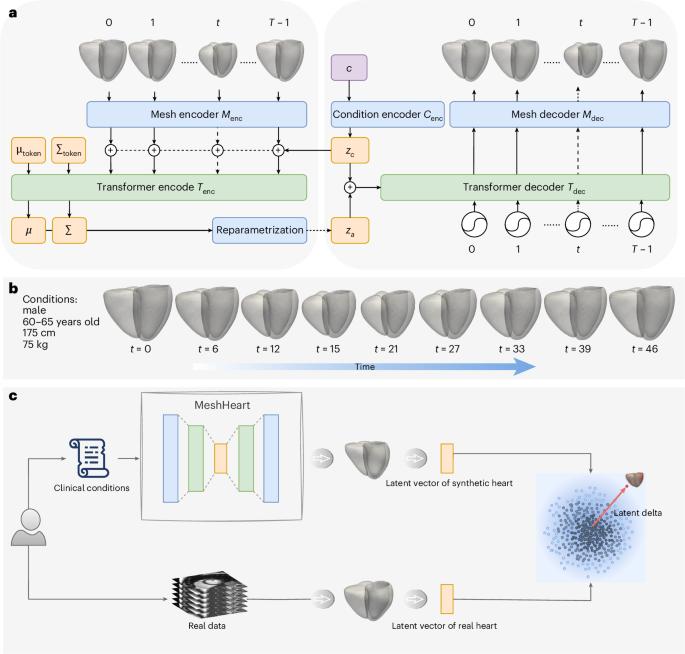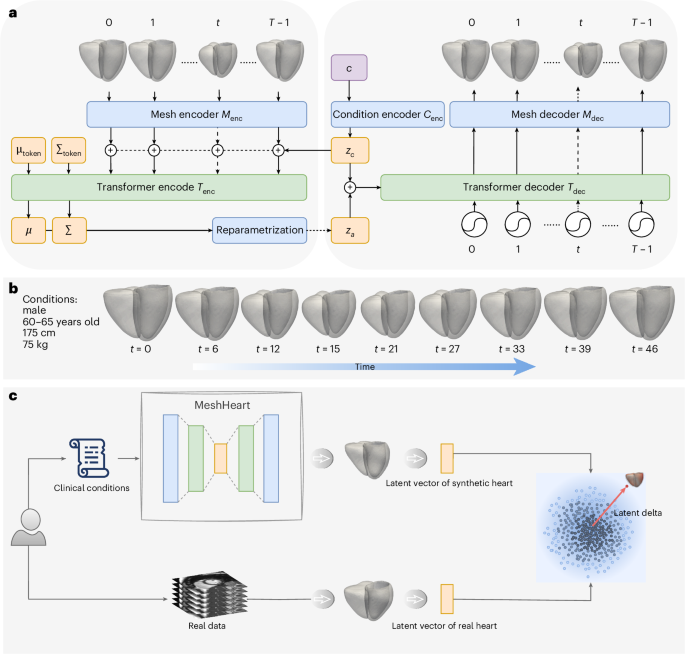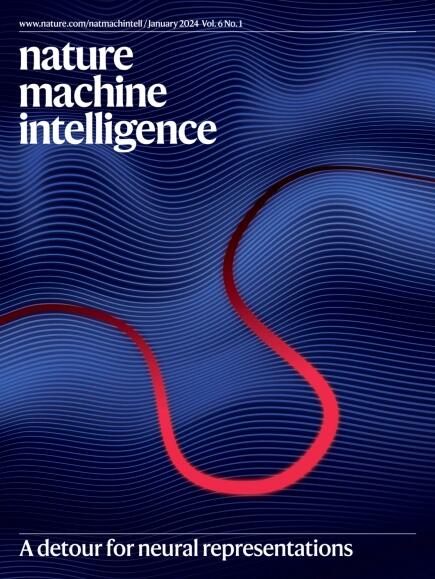一个个性化的时间分辨三维网格生成模型揭示正常的心脏动力学
IF 23.9
1区 计算机科学
Q1 COMPUTER SCIENCE, ARTIFICIAL INTELLIGENCE
引用次数: 0
摘要
了解心脏的结构和运动对于诊断和管理心血管疾病至关重要,心血管疾病是全球死亡的主要原因。受人口统计学、人体测量学和疾病因素的影响,心脏形状和运动模式有很大差异。解开正常的形状和运动模式,了解每个个体如何偏离常规,将有助于准确的诊断和个性化的治疗策略。为此,我们开发了一个条件生成模型,MeshHeart,来学习心脏左右心室的形状分布和运动模式。为了对高维时空网格数据建模,MeshHeart使用几何编码器来表示潜在空间中的心脏网格,并使用时间转换器来模拟潜在表征的运动动力学。基于MeshHeart,我们研究了3D + t心脏网格序列的潜在空间,并提出了一种距离度量,即潜在delta,它量化了真实心脏与其个性化规范模式的偏差。这里,3D + t指的是随时间变化的三维数据。在使用来自UK Biobank的38,309名参与者的大型心脏磁共振图像数据集的实验中,MeshHeart在心脏网格序列重建和生成方面表现出高性能。潜伏空间特征对心脏病的分类具有鉴别作用,而在全现象关联研究中,潜伏δ与临床表型表现出很强的相关性。本文章由计算机程序翻译,如有差异,请以英文原文为准。


A personalized time-resolved 3D mesh generative model for unveiling normal heart dynamics
Understanding the structure and motion of the heart is crucial for diagnosing and managing cardiovascular diseases, the leading cause of global death. There is wide variation in cardiac shape and motion patterns, influenced by demographic, anthropometric and disease factors. Unravelling normal patterns of shape and motion, and understanding how each individual deviates from the norm, would facilitate accurate diagnosis and personalized treatment strategies. Here, to this end, we developed a conditional generative model, MeshHeart, to learn the distribution of shape and motion patterns for the left and right ventricles of the heart. To model the high-dimensional spatio-temporal mesh data, MeshHeart uses a geometric encoder to represent cardiac meshes in a latent space and a temporal transformer to model the motion dynamics of latent representations. Based on MeshHeart, we investigate the latent space of 3D + t cardiac mesh sequences and propose a distance metric, latent delta, which quantifies the deviation of a real heart from its personalized normative pattern. Here, 3D + t refers to three-dimensional data evolving over time. In experiments using a large cardiac magnetic resonance image dataset of 38,309 participants from the UK Biobank, MeshHeart demonstrates high performance in cardiac mesh sequence reconstruction and generation. Latent space features are discriminative for cardiac disease classification, whereas latent delta exhibits strong correlations with clinical phenotypes in phenome-wide association studies. MeshHeart, a conditional generative model for time-resolved 3D heart mesh generation, is proposed by Qiao et al. to unravel heart motion patterns. Their findings could advance diagnosis and treatment strategies for cardiovascular diseases.
求助全文
通过发布文献求助,成功后即可免费获取论文全文。
去求助
来源期刊

Nature Machine Intelligence
Multiple-
CiteScore
36.90
自引率
2.10%
发文量
127
期刊介绍:
Nature Machine Intelligence is a distinguished publication that presents original research and reviews on various topics in machine learning, robotics, and AI. Our focus extends beyond these fields, exploring their profound impact on other scientific disciplines, as well as societal and industrial aspects. We recognize limitless possibilities wherein machine intelligence can augment human capabilities and knowledge in domains like scientific exploration, healthcare, medical diagnostics, and the creation of safe and sustainable cities, transportation, and agriculture. Simultaneously, we acknowledge the emergence of ethical, social, and legal concerns due to the rapid pace of advancements.
To foster interdisciplinary discussions on these far-reaching implications, Nature Machine Intelligence serves as a platform for dialogue facilitated through Comments, News Features, News & Views articles, and Correspondence. Our goal is to encourage a comprehensive examination of these subjects.
Similar to all Nature-branded journals, Nature Machine Intelligence operates under the guidance of a team of skilled editors. We adhere to a fair and rigorous peer-review process, ensuring high standards of copy-editing and production, swift publication, and editorial independence.
 求助内容:
求助内容: 应助结果提醒方式:
应助结果提醒方式:


